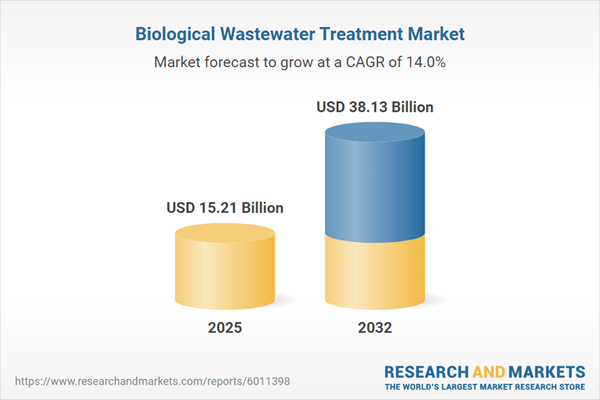Speak directly to the analyst to clarify any post sales queries you may have.
Biological wastewater treatment is increasingly vital in sustainable water management strategies, offering reliable solutions to escalating environmental and regulatory challenges. Senior executives in municipal utilities, industrial operations, and infrastructure sectors face expanding opportunities and evolving responsibilities in integrating cutting-edge biological systems for cleaner water and improved resource value.
Market Snapshot: Growth and Innovation in Biological Wastewater Treatment
The Biological Wastewater Treatment Market demonstrates robust momentum, progressing from USD 13.37 billion in 2024 to USD 15.21 billion in 2025, and is projected to reach USD 38.13 billion by 2032 at a CAGR of 13.98%. Vigorous investment in technology development, growing adoption in industrial and municipal sectors, and policy-driven market expansion are key dynamics shaping this transformation.
Scope & Segmentation of the Biological Wastewater Treatment Market
- Process Types: Aerobic (Activated Sludge, Biofilm Systems, Trickling Filter), Anaerobic (Anaerobic Filters, UASB), Anoxic (Denitrification Systems)
- Applications: Agricultural, Industrial (Food and Beverage, Petrochemical, Pharmaceutical, Pulp and Paper), Municipal
- Equipment: Aerators (Diffused Aeration, Mechanical Aeration), Clarifiers, MBR Modules, Reactors (Continuous Stirred Tank, Membrane Bioreactor, Sequencing Batch)
- Microorganism Types: Algae (Chlorella, Spirulina), Bacteria (Denitrifying, Nitrifying), Fungi (Filamentous, Yeast), Protozoa (Ciliates, Flagellates)
- Geographic Coverage: Americas (United States, Canada, Mexico, Brazil, Argentina, Chile, Colombia, Peru), Europe, Middle East & Africa (United Kingdom, Germany, France, Russia, Italy, Spain, Netherlands, Sweden, Poland, Switzerland, UAE, Saudi Arabia, Qatar, Turkey, Israel, South Africa, Nigeria, Egypt, Kenya), Asia-Pacific (China, India, Japan, Australia, South Korea, Indonesia, Thailand, Malaysia, Singapore, Taiwan)
- Key Providers: Veolia Environnement S.A., SUEZ S.A., Xylem Inc., Ecolab Inc., Pentair plc, Evoqua Water Technologies LLC, Kurita Water Industries, Ltd., Mitsubishi Chemical Holdings Corporation, Beijing Enterprises Water Group Limited, Ion Exchange (India) Limited
Key Takeaways for Decision-Makers
- Technology convergence, such as membrane bioreactors and digital process monitoring, is redefining system efficiency and operational control for biological wastewater treatment providers.
- Decentralized and modular treatment platforms enable flexible deployment, supporting both urban infrastructure upgrades and rural sanitation efforts.
- Advanced biological pathways—including aerobic, anaerobic, and anoxic systems—are tailored to diverse industry needs, from nutrient removal in agriculture to managing complex wastes in petrochemical and pharmaceutical sectors.
- Integration of energy recovery and nutrient recycling reflects a shift toward circular economy models, transforming waste into valuable resources.
- Collaborative approaches through joint ventures and performance-based contracts drive faster innovation and adaptation to region-specific regulatory and operational challenges.
Tariff Impact on the Biological Wastewater Treatment Market
Since 2025, increased tariffs on critical components such as membrane modules, precision aerators, and advanced reactors have intensified cost pressures and extended lead times. Companies have responded by prioritizing local manufacturing, recertifying existing assets, and adopting modular equipment designs to counteract the effects on capital and operational expenditures. These measures have enhanced supply chain resilience and encouraged strategic sourcing diversification to mitigate the impact of continuing trade policy volatility.
Methodology & Data Sources
Research for this report utilized comprehensive secondary analysis from industry publications and regulatory filings, complemented by primary interviews with sector experts. Site visits provided practical insights into technology integration, process optimization, and performance metrics. Data triangulation ensured accuracy across process categories, application sectors, equipment types, and regional deployment patterns.
Why This Report Matters
- Enables senior leaders to benchmark operational and procurement strategies against evolving global standards in biological wastewater treatment.
- Supports informed investment in advanced technologies, helping organizations adapt to technology shifts, regulatory frameworks, and sustainability demands.
- Provides actionable segmentation and competitive intelligence to optimize decision-making in market entry, partnership, or technology adoption.
Conclusion
Leaders seeking future-ready water management solutions will benefit from clear insight into innovative biological treatment systems, evolving market structures, and the strategic levers driving efficiency and sustainability in this high-growth sector. The report delivers a foundation for resilient and opportunity-driven decision-making in a dynamic regulatory and technology landscape.
Additional Product Information:
- Purchase of this report includes 1 year online access with quarterly updates.
- This report can be updated on request. Please contact our Customer Experience team using the Ask a Question widget on our website.
Table of Contents
3. Executive Summary
4. Market Overview
7. Cumulative Impact of Artificial Intelligence 2025
List of Figures
Samples

LOADING...
Companies Mentioned
The key companies profiled in this Biological Wastewater Treatment market report include:- Veolia Environnement S.A.
- SUEZ S.A.
- Xylem Inc.
- Ecolab Inc.
- Pentair plc
- Evoqua Water Technologies LLC
- Kurita Water Industries, Ltd.
- Mitsubishi Chemical Holdings Corporation
- Beijing Enterprises Water Group Limited
- Ion Exchange (India) Limited
Table Information
| Report Attribute | Details |
|---|---|
| No. of Pages | 189 |
| Published | October 2025 |
| Forecast Period | 2025 - 2032 |
| Estimated Market Value ( USD | $ 15.21 Billion |
| Forecasted Market Value ( USD | $ 38.13 Billion |
| Compound Annual Growth Rate | 13.9% |
| Regions Covered | Global |
| No. of Companies Mentioned | 11 |









